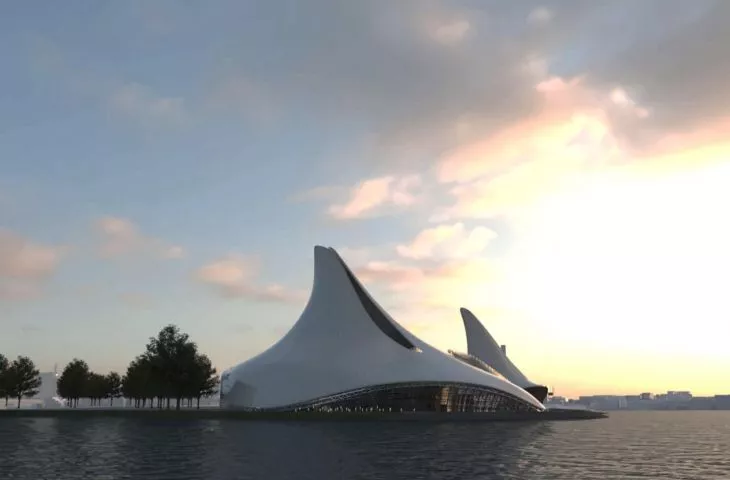What should a modern opera house look like? What makes the building a cultural icon of the city? This was the question posed by the organizers of the Opera by the Sea competition. The {tag:studenci}, a graduate of the Poznan University of Technology, answering the given topic, created a project on the axis. His proposal received an honorable mention Editor's choice.
For centuries, the popularity of theater and opera performances throughout Europe has created a new typology of venues called opera houses. They have become the cultural center of the city, hosting legendary artists and musicians. Opera houses in Italy, Vienna, Germany and England were among the first glamorous buildings, serving as the city's showcase. They were often erected in the commercial district of the city. Attending the opera was a social occasion that showcased the prosperity of the upper middle class. Attending an opera performance was a sign of upper middle-class prosperity.
the project on the axis received the distinction of Editor's choice
© Pawel Frąckowiak
opera in Tallinn
The goal of the competition organized by the UNI platform was to design a contemporary opera house for the Estonian capital. The building was to become an architectural icon that would last for decades and become the cultural center of Tallinn.
The jury composed of: Johan Tali, Karli Luik, Jacques Ferrier, Bryan Schmidt, Pauline Marchetti, Pauline Marchetti, evaluated the works submitted from around the world. Among them was the project on the axis by Pawel Frąckowiak, which received an honorable mention Editor's choice.
The design challenge was to maintain the relationship between the waterfront landscape and the architecture of the city
© Pawel Frąckowiak
on the axis of the city
The project on the axis - opera by the sea is located on the waterfront in Tallinn, the capital of Estonia. Pawel Frąckowiak's work was at the same time a master's degree, carried out at the Poznan University of Technology under the supervision of Magdalena Gyurkovich, PhD. The guiding idea of the project was to obtain a building with the desired height of Tallinn's existing modern architecture, while maintaining a relationship with the surrounding harbor and horizontal landscape. The division into three blocks connected by a common first floor resulted in an interesting form in the landscape of the city and the waterfront, referring to naval architecture, and crystallized the functional layout.
The building is distinguished by a roof with rounded shapes
© Pawel Frąckowiak
The architect's goal was to revitalize and organize the space between the city's harbor and the abandoned Linnahall. It was also necessary to create an axis between the city and the designed architecture. It was quite a design challenge to maintain the relationship between the waterfront landscape and the city's architecture while preserving the iconic character of the designed opera house.
The design premise was divided into component blocks, connected by a common first floor
© Pawel Frąckowiak
The author began the design process by analyzing the volume of the opera house's individual spaces, which he covered with a roof of fluid shapes. He based the initial concept of the form on a vertical element of the desired height, visible from the city center and forming an axis with it. The design premise was divided into component blocks, connected by a common first floor. In this way, the impact of the building's monumentality on the cityscape was balanced. In the lower part, the architect used lightweight glazing mounted on a truss structure, above which there are rounded roof slopes.
While designing the body of the building, Pawel Frąckowiak developed the functional program in parallel. The largest building includes a main hall with an auditorium, a stage, side pockets, auxiliary rooms and rooms for artists. The smaller block contains a small hall for 400 people and accompanying rooms. The third houses rehearsal rooms for ballet, orchestra and separate rooms for individual practice. The whole is connected by a common first floor, which is the main communication between the building blocks and technical spaces.
main auditorium
The interior of the main auditorium refers to the external form of the building
© Pawel Frąckowiak
The main auditorium has 1,949 seats, including 4 for the disabled. Its interior was designed by the author with reference to the external form of the building. The ceiling is made of curved surfaces lit from the inside. Balconies are formed by irregular, rounded forms finished with acoustic cladding. The auditorium has been divided into four main levels: the lower and upper auditoriums, and Balcony I and II. The balconies were designed to allow sound to penetrate the recesses within them. Suspended and adjustable ceiling surfaces act as acoustic adaptations for the auditorium, allowing adjustments and tuning.
sea view opening
The development concept for the plot was based on the city-sea relationship. The main ent rances to the building are from the sea. Two roads lead to the opera house: the first, designed as a representative boulevard along the coast. The second directs to the space above the first floor between the buildings, preserves the compositional axis of the opening to the sea.
An external spiral staircase leads to the main entrance located on the lower level
© Pawel Frąckowiak
Along the boulevard there is a descent to the sea in the form of a staircase with greenery. By creating an avenue of trees, the author has maintained and emphasized the connection with the Linnahall building and the city. At the front of the opera house there is a representative staircase leading to the space between the buildings, designed as an outdoor event venue and recreational area. In this zone, the gaze is directed to the landscape between the buildings, which is a view opening towards the sea. An exterior spiral staircase leads to the main entrance located on the lower level.














































